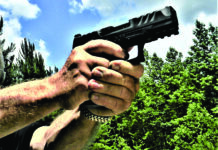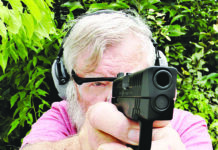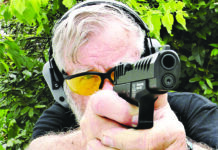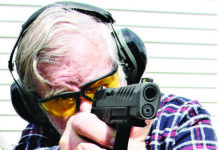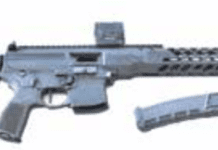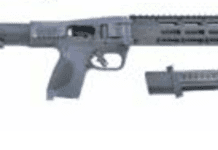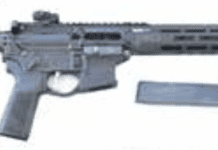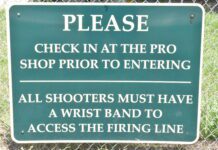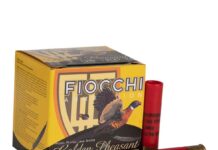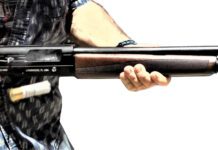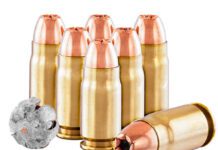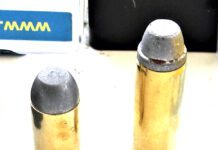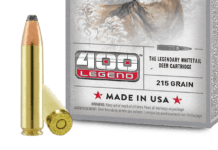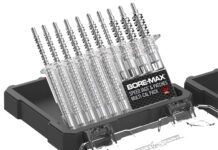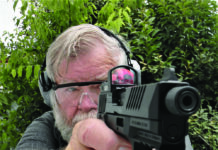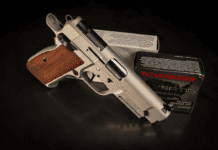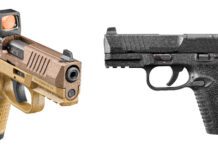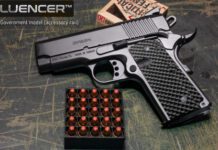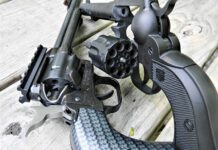Will Taurus Stay in Florida? Georgia Makes a Run at Company
Post a Hunting Photo, Go to Jail
A case to be heard by Supreme Court of the United States might result in felony charges and jail time for any person, outlet or entity that shows or sells depictions of hunting activities. Taking, selling or publishing images of hunting, fishing or trapping could mean felony charges and jail time.
NICS Checks Up 18.1 Percent in June
12-Gauge Autoloader Shoot-Out: Beretta, Benelli, and Remington
12-Gauge Autoloader Shoot-Out: Beretta, Benelli, and Remington
Beretta A391 Teknys Gold Sporting J391T78 12 Gauge
BATFE Rules on Manufacturing of Firearms Points
Duel at the Mostly OK Corral: 12-Ga. Cowboy Action Shotguns
Duel at the Mostly OK Corral: 12-Ga. Cowboy Action Shotguns
Remington Offers New 870 Express Compact Shotgun In Mossy Oak Pink Camouflage
Home-Defense 12-Gauge Pumps: Ithaca, Remington, Mossberg
Perhaps due to the "Obama-effect"—wherein the fear of future gun bans is driving sales—the home-defense/tactical class of self-defense shotguns is booming like never before. But we must recognize that other factors figure into the segment's sales rise as well, not the least of which is that a 12-gauge pump-action shotgun is an effective close-quarters weapon.
To wit: The M97 version of John Browning's Winchester 1897 shotgun was the original "trench-sweeper." Widely considered the first truly successful pump shotgun, the M97 was fitted with a heat shield and the M1917 16-inch bayonet for combat duty. The highly effective use of the shotgun by United States forces in WWI had a dramatic effect on the morale of front-line German troops. As a result, on September 19 of 1918, the German government issued a diplomatic protest against the American use of shotguns, alleging that the law of war prohibited the shotgun. The 5+1 capacity M97 and OO buckshot defined the fast-handling, reliable close-quarters shotgun for about 30 years, the platform of the high-capacity pump persisting through to present day.
The reason to consider a shotgun for personal defense is what many combat studies have shown: the hit probability of a shotgun is roughly twice that of a rifle. For home defense, the shotgun is a quicker stopper than a handgun due to its being able to produce more wound trauma with multiple wound paths. It is considered easier to use in a high-stress situation, and minimizes wall penetration compared to some handgun ammunition. It is also economical to practice with.
Number 1 Buckshot is 30 caliber; it is the superior choice as defined by the International Wound Ballistics Association: "Number 1 buck is the smallest diameter shot that reliably and consistently penetrates more than 12 inches of standard ordnance gelatin when fired at typical shotgun engagement distances. A standard 2-inch 12-gauge shotshell contains 16 pellets of #1 buck. The total combined cross sectional area of the 16 pellets is 1.13 square inches. Compared to the total combined cross sectional area of the nine pellets in a standard #00 (double-aught) buck shotshell (0.77 square inches), the # 1 buck shotshell has the capacity to produce over 30 percent more potentially effective wound trauma. In all shotshell loads, number 1 buckshot produces more effective wound trauma than either #00 or #000 buck. Also, #1 buck is less likely to over-penetrate and exit an attacker's body." (For further reading, consult Dr. Martin Fackler and Duncan MacPherson's works on bullet penetration and wounding ballistics.)
This match-up includes the Ithaca Model 37 Defense Gun ($469), very close to the M37 "Trench Gun" that saw action in WWII and in Vietnam; the Remington Model 870 Tac-2 FS ($692), and the Mossberg 590A1 w/Black Aluminum Adjustable Stock ($693). The Mossberg 590A1 in various configurations is currently an active service shotgun for the U.S. Military. Here's what our test team thought about the trio:
Home-Defense 12-Gauge Pumps: Ithaca, Remington, Mossberg
Perhaps due to the "Obama-effect"—wherein the fear of future gun bans is driving sales—the home-defense/tactical class of self-defense shotguns is booming like never before. But we must recognize that other factors figure into the segment's sales rise as well, not the least of which is that a 12-gauge pump-action shotgun is an effective close-quarters weapon.
To wit: The M97 version of John Browning's Winchester 1897 shotgun was the original "trench-sweeper." Widely considered the first truly successful pump shotgun, the M97 was fitted with a heat shield and the M1917 16-inch bayonet for combat duty. The highly effective use of the shotgun by United States forces in WWI had a dramatic effect on the morale of front-line German troops. As a result, on September 19 of 1918, the German government issued a diplomatic protest against the American use of shotguns, alleging that the law of war prohibited the shotgun. The 5+1 capacity M97 and OO buckshot defined the fast-handling, reliable close-quarters shotgun for about 30 years, the platform of the high-capacity pump persisting through to present day.
The reason to consider a shotgun for personal defense is what many combat studies have shown: the hit probability of a shotgun is roughly twice that of a rifle. For home defense, the shotgun is a quicker stopper than a handgun due to its being able to produce more wound trauma with multiple wound paths. It is considered easier to use in a high-stress situation, and minimizes wall penetration compared to some handgun ammunition. It is also economical to practice with.
Number 1 Buckshot is 30 caliber; it is the superior choice as defined by the International Wound Ballistics Association: "Number 1 buck is the smallest diameter shot that reliably and consistently penetrates more than 12 inches of standard ordnance gelatin when fired at typical shotgun engagement distances. A standard 2-inch 12-gauge shotshell contains 16 pellets of #1 buck. The total combined cross sectional area of the 16 pellets is 1.13 square inches. Compared to the total combined cross sectional area of the nine pellets in a standard #00 (double-aught) buck shotshell (0.77 square inches), the # 1 buck shotshell has the capacity to produce over 30 percent more potentially effective wound trauma. In all shotshell loads, number 1 buckshot produces more effective wound trauma than either #00 or #000 buck. Also, #1 buck is less likely to over-penetrate and exit an attacker's body." (For further reading, consult Dr. Martin Fackler and Duncan MacPherson's works on bullet penetration and wounding ballistics.)
This match-up includes the Ithaca Model 37 Defense Gun ($469), very close to the M37 "Trench Gun" that saw action in WWII and in Vietnam; the Remington Model 870 Tac-2 FS ($692), and the Mossberg 590A1 w/Black Aluminum Adjustable Stock ($693). The Mossberg 590A1 in various configurations is currently an active service shotgun for the U.S. Military. Here's what our test team thought about the trio:


